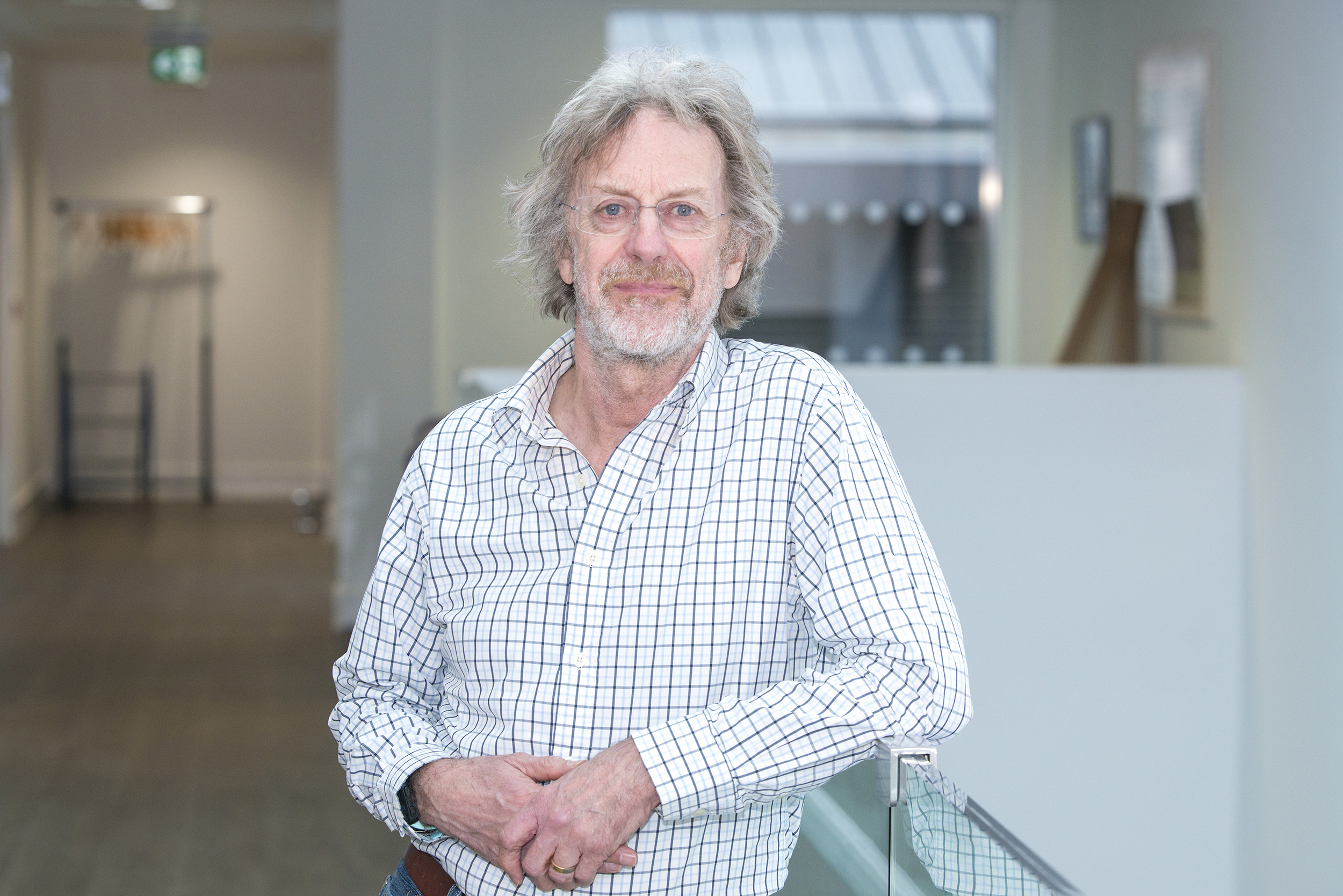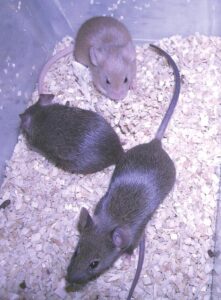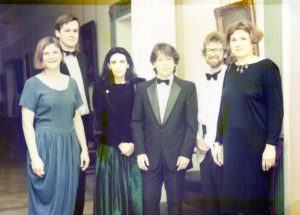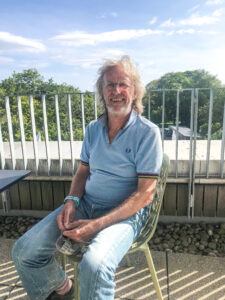A conversation with Ian Jackson

I met with Ian Jackson following his retirement to talk about his career, his ideas, the changing face of science, people and the future. We sit contemplating the view over the City of Edinburgh, on the upper terrace of the Institute of Genetics and Cancer, at the Western General Hospital where Ian has worked for 36 years.
I ask Ian about his early education and path to science.
“In 1973 I went from grammar school in Accrington, Lancashire to do an undergraduate degree in Biochemistry at Keble College, Oxford. My biology teacher had asked me “Are you going to apply to Oxford or Cambridge, because if you are not, tell me why not!” So I applied.
The friends I made in Oxford are still friends now, I was also very involved in the mountaineering club; every second weekend we were away climbing. Midway through my degree my parents were killed in a traffic accident, which could have seriously changed things but to her credit my younger sister took over running the home and keeping an eye on our younger brother. In my final year I did a project with Ian Walker on RNA from the slime mould Physarum polycephalum. (Dame) Kay Davies was just finishing her PhD there when I was doing my undergraduate project.
Restriction enzymes had just been discovered and recombinant DNA technology was becoming a possibility – I felt this was the direction I wanted to take. I had met Bob Williamson when he gave a seminar and this led to a PhD place with him at St Mary’s Hospital in London, focused on haemoglobinopathies. For the first two years I was just figuring out how to clone DNA.”
I query Ian about how one went about cloning DNA in days gone by…
“Well the technology moved so fast! We started with columns and tracked DNA by Southern Blot, then moved to electrophoresis through ‘wedding cake’ sized slabs of agarose – the ‘Gene Machine’, invented by Ed Southern. This meant starting with many hundreds of milligrams of DNA. But within a year we were making whole genome libraries of partially digested DNA.”
Ian describes the possibilities that arose with the cloning of the globin genes and the advances in this technology.
“We had a collaboration with the thalassemia clinic and were some of the first to clone disease-specific mutated genes (actually some of the first to clone any human gene). I cloned a beta-zero thalassemia gene which turned out to have a nonsense mutation at codon 39. It was a puzzle as this patient had no beta globin mRNA and we speculated in the paper that the nonsense mutation made the transcript less stable. Of course it was what we now call nonsense mediated decay.”
Skimming the paper I notice that all restriction enzymes were made at St Mary’s with the exception of EcoR1, purchased from Porton Down and think how much the ready availability of enzymes and other reagents at the touch of a button have expanded the horizons of science.
Ian then relates how as a postdoc in Don Brown’s lab, at the Carnegie Institute in Baltimore, he failed to clone a transcription factor, Tf3a, found to be abundant in Xenopus oocytes.
“We tried to do by protein sequencing then by collaborating to have oligos made. You couldn’t order oligos then – you had to collaborate with a group who made them. It turned out the protein sequence was wrong so we didn’t manage to clone it. I’m still not sure what happened.”
Ian did though publish a Cell paper on the protein domains of this factor, so it clearly wasn’t a total bust. The proximity to other researchers in Baltimore also sparked some new ideas.
“I shared lab space in Baltimore with Gerry Rubin’s postdocs. They worked on Drosophi eye mutation and it struck me that it would be great if we had a system where we could look at multiple alleles of a mammalian gene. Mice seemed to be a tractable system and I developed an interest in coat colour, which I felt must be determined by different allele combinations. DNA technology was just coming into embryology and I moved back to the UK in 1983, on an MRC fellowship, to work with Ann McClaren.”
Ian begins to describe the origins of some of the work he is best known for – the genetic determination of coat colour in mice, and hair colour in humans.
“I had met Ann McClaren previously through Bob Williamson and moved to the fantastic environment of her lab in London. It was a fantastic environment. There was so much unknown about the molecular biology of development and the small group of us there talked constantly about the possibilities. Homeoboxes had just been described – quite a ‘trendy’ topic and I did some work on those and published in Nature though these days it would probably be an undergraduate 6 week project. However I was really interested in coat colour and the interactions of allele combinations. The way in seemed to be through the tyrosinase gene, which most people believed was coded at the albino locus.”

Ian and colleagues demonstrated that a human MC1R BAC transgene accurately restores pigmentation to Mc1r mutant mice.
Ian describes how, through collaboration, sharing of reagents, and a good understanding of mouse genetics, he began to learn more about the genetic architecture of coat colour.
“I detoured home from a US meeting via Baltimore to pick up an antibody against tyrosinase to screen an expression library and got clones this way. At the same time a group in Basel had published that they had cloned tyrosinase, and I asked for this cDNA. Neither clone mapped to the albino locus. The Basel group had sequenced and found the gene mutated in an albino strain of mice – but it happened to be Balb/c. We know this mouse strain is mutant at both albino and brown loci – I mapped the mutated gene to the brown locus. When we looked at clones from the expression screen these did not map to the albino locus either, so we ended up with 3 related genes. This was the beginning.”
Ian then came here to Edinburgh having, at yet another fortuitous seminar, met Nick Hastie, the soon-to-be Director of the MRC Human Genetics Unit (HGU), University of Edinburgh. Having written a pre-email real letter to Nick, Ian came up to give a talk in Edinburgh. This was during the festival, which may have influenced Ian’s eventual choice of research home.
Ian breaks to recall an interlude between his London and Edinburgh positions which highlights two things Ian is known for – his capacity for problem solving and his love of adventure. Having solved a fiendishly tricky puzzle in the Observer newspaper, and submitted his reasoning for wanting to travel round the world (“I’ve read the books, I’ve seen the movies, but now I want to buy the t-shirts”), Ian and his now wife, scientist Sally Cross, embarked on a 6 week first-class round the world tour.
“We went to Delhi, Hong Kong, Beijing, Melbourne and so on though I have to tell you first class then was not as good as business class now. Apart from the food – that was good.”

Ian Jackson at the Lister Institute Centenary dinner in London, 1991. L-R Wendy Bickmore (now Director of the MRC HGU in the IGMM), Robin Allshire, Christina, Wolf Reik, Ian Jackson (HGU), Sally Cross. Picture provided by Ian Jackson.
We pause to reflect on the lack of good dining options at 36,000 feet.
Ian lives now in the house he and Sally bought 35 years ago, when he moved to join the MRC Clinical and Population Cytogenetics unit directed by Professor John Evans. He was supported by a Lister Fellowship. Three years later, in 1988, the Unit changed name to the MRC Human Genetics Unit.
I notice, as we talk, that when Ian describes his research direction and geographic moves he always seems to start with the people, Bob Williamson, Anne McClaren, Nick Hastie and ask him about this.
“In my early career Bob Williamson advised me to think about where I wanted to go and who I wanted to work with and write to them. Don’t think about the topic – find a good lab!”
Ian gives the example that Ann [McClaren] had a history of using mouse coat colour genes, so she was interested in his research topic, and she wanted to bring in people who knew DNA technology. But the project was his own.
“Yes some people might think movement between my PhD and postdoc represented a complete change of direction, though in those days the linking factor was the DNA technology. It was always natural to me to do my own thing. I moved several times in my career, to the US and back and I would always encourage getting new perspectives but I also think too much is made of ‘you have got to move somewhere else”. It doesn’t help people with families, and we know many people who have been very successful without moving. I would tell people to think about a good lab and mentor and then develop.”
I am curious as to which accomplishments stand out for Ian over the course of his career.
“I’ve been involved in the mouse genome project, in large scale mutagenesis projects and in developing and studying models for genetic eye diseases, but I think the melanocyte work is what stands out for me. The gene I cloned using Seymour Pomerantz’s Baltimore antibody that turned out not be be tyrosinase, but a related protein – we found it picked up melanocyte precursors and we could use it to track developing melanoblasts using in situ hybridisation. I collaborated with Karen Steel, who was interested in melanocytes in the ear and came to Edinburgh to do in situ hybridisation and track development. This led to uncovering effects of mutations of the [receptor tyrosine kinase] Kit gene on cell migration and developmental trajectory of melanoblasts, work that we continued many years later with Richard Mort.”
“However I think the thing that everyone talks about is the red hair stuff!”
In collaboration with Jonathan Rees and his postdoc, then in Newcastle, Ian helped demonstrate some years ago that most occurrences of red hair in humans were due to two copies of a variant MC1R gene.
“That wasn’t primarily done in my lab initially but to me the mouse genetics told the story that the the recessive yellow mutation in mice was down to MC1R, and the protein at the Agouti locus must be an antagonist, and probably red hair in humans was due to combinations of the same two genes. When Roger Cone and Joe Nadeau cloned the MC1R gene in mice I began to workon the human gene with Jonathan Rees – who has been in Edinburgh now for many years.”

Ian’s completing his last Munro. Image credit: Phillipe Gautier
I ask Ian if he were to start his career at this point in time, what topic of research would interest him. Ian politely defers on this question and reflects on what else he might have done.
“If I had trained over I would get more skills in bioinformatics, statistics and data science. Genetics of natural variation in populations is endlessly interesting. How genetic variation leads to natural phenotypic variation – there is a continuum of natural variation to disease-associated variation so this does benefit clinical genetics.”
Indeed Ian has recently progressed along these lines with a much bigger study of hair colour in UK Biobank in collaboration with Albert Tenesa.
“The same is true for eyes. Our work on mutations found to cause changes in mice are associated with natural human variation in eye size, which can lead to myopia.”
I have to ask the classic question – what would be Ian’s advice to a young scientist now?
“Find a question you want to answer– don’t look to where the money is. If it’s a problem in genetics then learn statistics and bioinformatics.”
So what will Ian do now?

Ian Jackson on Institute of Genetics and Cancer terrace. Photo by Helen Nickerson.
“We bought a new campervan on Monday; hopefully now travelling will be easier. And likely hillwalking and running [Ian has done more than 20 marathons]. I’m keeping up connections with the Institute as an Emeritus Professor and I’ve other things going on. I am now a trustee for the MRC pension scheme and I chair the research advisory board at Waltham Pet Care Science Institute – it’s really interesting, they have everything from nutrition, health, data science.. The genetically encoded nature of behaviour is really interesting to me – like herding behaviour in dogs.”

Ian Jackson and Sally Cross with the glass sculpture presented to Ian upon his retirement created by David Mola and inspired by Ian’s work. Photo by Craig Nicol.
Ian reflects on the impact of Covid-19 and associated restrictions in recent times.
“It will be great to get back to in person seminars. It would be great to get back to the social aspects of science. To me science is a social enterprise. The labs I have been in were just great environments and most people have gone on to have successful careers. Kay Davies, Robin Lovell-Badge, Pat Hunt, Hugh Pelham.”
At this point our conversation delightfully descends into scientific celebrity gossip, we finish our coffee in the sunshine and Ian heads back into Edinburgh, unsurprisingly to a Fringe show, as the population of Edinburgh begins to emerge from lockdown.
We all wish Ian well for his retirement and are glad that, through his Emeritus status, we will have continued scientific interactions.
See also: Emeritus Professor Ian Jackson retires



